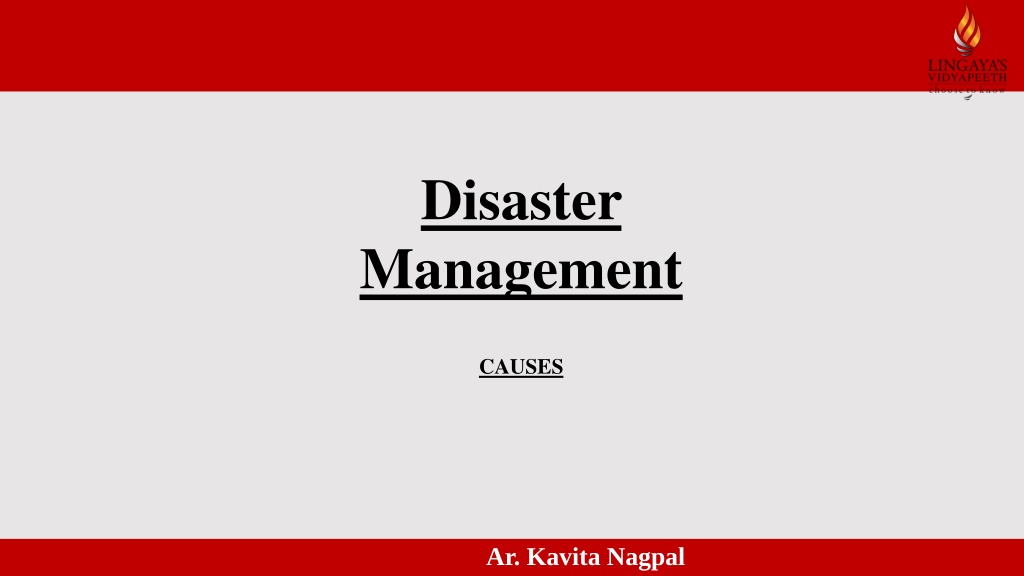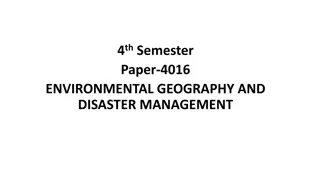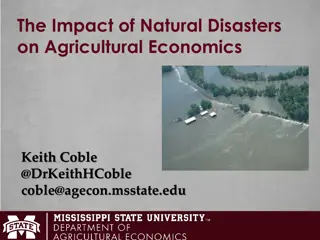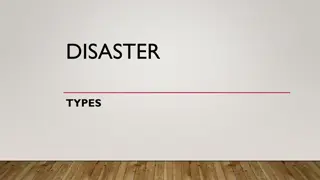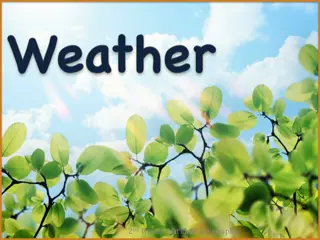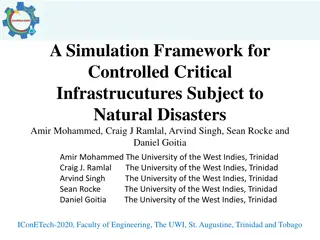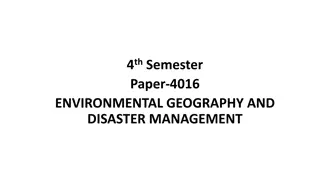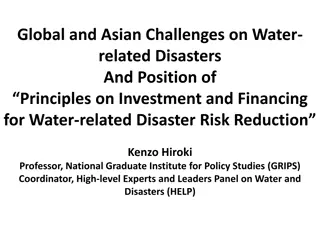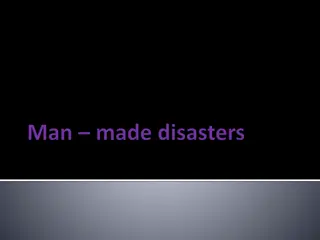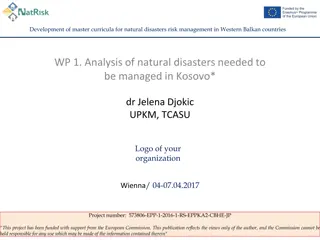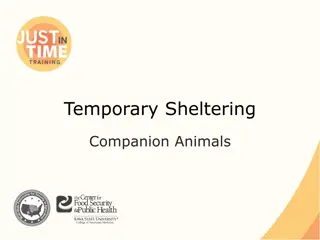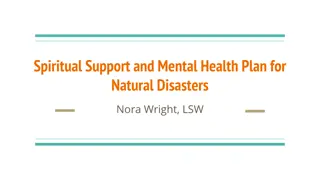Understanding Natural Disasters and Their Causes
Explore the various types of natural disasters such as meteorological, geophysical, hydrological, climatological, and biological events, each with unique causes like storms, earthquakes, floods, droughts, wildfires, and more. Learn how these disasters impact the environment and living organisms.
Download Presentation

Please find below an Image/Link to download the presentation.
The content on the website is provided AS IS for your information and personal use only. It may not be sold, licensed, or shared on other websites without obtaining consent from the author. Download presentation by click this link. If you encounter any issues during the download, it is possible that the publisher has removed the file from their server.
E N D
Presentation Transcript
Disaster Management CAUSES Ar. Kavita Nagpal
Types of disasters & its Causes NATURAL DISASTERS Natural Disasters: Natural disasters are primarily natural events. The natural disaster category can be divided into five disaster group: biological, geophysical, meteorological, hydrological and climatological. 1. Meteorological Disasters: Meteorological disasters are events triggered by short-live or small to meso-scale atmospheric processes. The storms can be subdivided into: Tropical storm - Tropical disturbance, tropical depression, tropical storm and hurricane Extra-tropical storm Local/Convective storms i. ii. iii. 2. Geophysical Disasters: Geophysical disasters are events originating from the solid earth. i. Two important factors are Intensity/magnitude (Richter scale). The epicentre. ii. Volcano: Volcanic activity describe both the transport of magma and/or gases to the earth s surface, which can be accompanied by tremors and eruptions. Earthquake: Earthquakes refer to tremors of the Earth.
Types of disasters & its Causes NATURAL DISASTERS iii. Mass Movement: Mass movement refers to the movement of a quantity of debris/land/snow/ice that slides down a mountainside under the force of gravity. It can be subdivided into various types: Rockfall refers to quantities of rock or stone falling freely from a cliff face. Subsidence is the downward motion of the earth s surface. Avalanche is any kind of rapid snow/ice movement and refers to the movement of quantity of snow or ice that slides down a mountainside under the force of gravity. 3. Hydrological Disasters: These are the events caused by deviations in the normal water cycle and/or overflow of bodies of water caused by the wind set-up. It can be further categorized into the following: i. General floods. ii. Storm surge/Coastal flood. 4. Climatological Disasters: According to Centre for Research on the Epidemiology of Disasters (CRED) it is events caused by long lived/meso to macroscale processes. These are i. Disasters caused by extreme temperatures Heat wave, Cold wave, Winter storm. ii. Drought Drought is a long-enduring event caused by lack of rainfall. iii. Wildfire Wildfire refers to an uncertain burning fire, usually in wild lands, which causes damage to forests, agriculture, infrastructure and buildings.
Types of disasters & its Causes NATURAL DISASTERS 5. Biological Disasters: are disasters caused by the exposure of living organisms to germs and toxic substances. These are i. Epidemic Either an unusual increase in the number of cases of an infectious disease which already exists in the region or population concerned or the appearance of an infection previously absent from a region is termed as epidemic. ii. Insect infestation Invasive incursion and development of insects or parasites affect humans, animals, crops and materials adversely. iii. Animal stampede A stampede is an act of mass impulse among herd animals in which the herd together starts running with no clear direction or purpose. Natural Disasters: According to reports, in 2012, there were 905 natural catastrophes worldwide, out of which 93% were natural disasters: 5% - Meteorological 36% - Hydrological 12% - Climatological 7% - Geophysical
Types of disasters & its Causes NATURAL DISASTERS
Types of disasters & its Causes MAN-MADE DISASTERS Technological or man-made hazards are events that are caused by humans and occurs in or close to human settlements. These are mostly caused due to certain human conduct. 1. i. Social Disasters: Arson Arson is the crime of intentionally and cruelly setting fire to buildings, wild lands, vehicles or other property with the intention to cause damage. Civic disorders Also known as civic unrest or civic strife caused by a group of people. Terrorism Is the systematic use of violence (terror) as a means of coercion for political purposes. ii. iii. 2. i. Political Disasters: It is of following type. War Is an organized and often prolonged conflict that is carried out by states or non-state actors. Is characterized by extreme violence, social disruption and economic destruction. Types of wars based on weapons used Chemical weapons (CW) A device that uses chemical formulated to inflict death or human beings. Biological weapons Uses biological agents (bacteria, virus & fungi) for mass destruction and are also known as germ warfare. Nuclear weapons Is a device that derive its destructive force from nuclear reactions. a) b) c)
Types of disasters & its Causes MAN-MADE DISASTERS d) Armed conflict Is a contested incompatibility which concerns government and/or territory where the use of armed force between two parties, of which at least one is the government of a state, resulted in at least 25 battle related deaths Journal of peace Research. ii. Massacre A massacre is a specific incident in which a military force, mob or other group kill many people and the perpetrating party is perceived as in control of force, where the victimized party is perceived as helpless or innocent. 3. Industrial Disasters: It is of following types: i. Chemical Spill: Is a release occurring during the production, transportation or handling of hazardous chemical substances. ii. Explosion: An explosion can involve industrial structures. An explosion is a rapid increase in volume and release of energy in an extreme manner. Those are of a) Nuclear Plant explosion and radiation. b) Explosion at other industrial plants. iii. Transport accident Transport accidents refer to accidents involving mechanized modes of transport. They are of a) Air b)Water c) Railways d)Roadways
Types of disasters & its Causes MAN-MADE DISASTERS iv. Engineering Failure: Engineering is the science and technology used to meet the needs and demands of society. These includes buildings, aircrafts, etc. eg. Structural collapses. 4. Human Disasters: Human disasters are disasters that take place due to intentional or unintentional human behaviour. i. Human error of judgement. a) Stampede b) Airplane crashes c) Road accidents ii. a) b) Poisoning : Food poisoning Carbon monoxide (CO) poisoning A disaster is an unfortunate event that causes a large number of fatalities and damages. The increasing trends towards losses of both lives and property can be attributed to two broad reasons: The increase in the population density worldwide. The standards of living have augmented has various dimensions of disaster Economic, Political, Psychological & Social.
Types of disasters & its Causes MAN-MADE DISASTERS
Hazard What is a Hazard ? How is it classified?. Hazard may be defined as a dangerous condition or event, that threat or have the potential for causing injury to life or damage to property or the environment. The word hazard owes its origin to the word hasard in old French and az-zahr in Arabic meaning chance or luck . Hazards can be grouped into two broad categories namely natural and manmade. 1. Natural hazards are hazards which are caused because of natural phenomena. (hazards with meteorological, geological or even biological origin). Ex. cyclones, tsunamis Landslides, floods, drought, fires are socio-natural hazards since their causes are both natural and man made. 2. Manmade hazards are hazards which are due to human negligence. Manmade hazards are associated with industries or energy generation facilities and include explosions, leakage of toxic waste, pollution, dam failure, wars, etc.
Hazard VARIOUS TYPES OF HAZARDS
Vulnerability Vulnerability may be defined as The extent to which a community, structure, services or geographic area is likely to be damaged or disrupted by the impact of particular hazard, on account of their nature, construction and proximity to hazardous terrains or a disaster prone area. Vulnerabilities can be categorized into Physical, Social, Economical & Environmental vulnerabilities.
Vulnerability Physical Vulnerability: It includes notions of who and what may be damaged or destroyed by natural hazard such as earthquakes or floods. It is based on the physical condition of people and elements at risk such as buildings, infrastructure etc; and their proximity, location and nature of the hazard. It also relates to the technical capability of building and structures to resist the forces acting upon them during a hazard event. Social Vulnerability: It refers to the inability of the affected population to endure unfavorable impacts of hazards. It includes social aspects such as levels of literacy, good governance, social justice, conventional values, customs and ideological beliefs. It seeks to estimate the effects of events on vulnerable groups of society to respond to hazards Economic Vulnerability: It refers to potential impacts of hazards on assets and business processes. The level of economic vulnerability is dependent to a great extent on the economic status of individuals, communities and nations. Environmental Vulnerability: It is the aftermath of natural resources depletion and resource degradation.
Risk and Capacity Risk: Is a situation involving exposure to danger or the possibility that something unpleasant or unwelcome will happen. In the context of disaster management, risk is viewed as the product of the interaction of potentially damaging event and vulnerable conditions of a society or element exposed Capacity: Is defined as the resources, means and strengths which exist in households and communities which enable them to cope with, withstand, prepare for, prevent, mitigate or quickly recover from disaster . Two types: Physical Capacity Socio-economic Capacity
